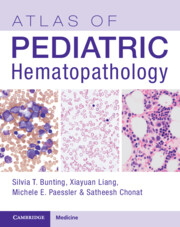Book contents
- Atlas of Pediatric Hematopathology
- Atlas of Pediatric Hematopathology
- Copyright page
- Contents
- Contributors
- Section I Peripheral Blood
- Section II Normal and Non-neoplastic Hematolymphoid Diseases
- Section III Mature Lymphoid Neoplasm
- Chapter 8 Mature B-Cell Non-Hodgkin Lymphoma
- Chapter 9 Mature T-Cell and NK-Cell Non-Hodgkin Lymphomas
- Chapter 10 Hodgkin Lymphoma
- Chapter 11 Posttransplant Lymphoproliferative Disorder
- Chapter 12 Immunodeficiency-Associated Lymphoproliferative Disorders
- Section IV Precursor Hematopoietic Neoplasms and Related Neoplasms
- Section V Histiocytic Neoplasm and Miscellaneous Bone Marrow Diseases
- Index
- References
Chapter 11 - Posttransplant Lymphoproliferative Disorder
from Section III - Mature Lymphoid Neoplasm
Published online by Cambridge University Press: 25 November 2023
- Atlas of Pediatric Hematopathology
- Atlas of Pediatric Hematopathology
- Copyright page
- Contents
- Contributors
- Section I Peripheral Blood
- Section II Normal and Non-neoplastic Hematolymphoid Diseases
- Section III Mature Lymphoid Neoplasm
- Chapter 8 Mature B-Cell Non-Hodgkin Lymphoma
- Chapter 9 Mature T-Cell and NK-Cell Non-Hodgkin Lymphomas
- Chapter 10 Hodgkin Lymphoma
- Chapter 11 Posttransplant Lymphoproliferative Disorder
- Chapter 12 Immunodeficiency-Associated Lymphoproliferative Disorders
- Section IV Precursor Hematopoietic Neoplasms and Related Neoplasms
- Section V Histiocytic Neoplasm and Miscellaneous Bone Marrow Diseases
- Index
- References
Summary
Posttransplant lymphoproliferative disorders (PTLDs) comprise a heterogeneous category of lymphoid and plasmacytic proliferations occurring as a result of immunosuppression following solid organ or hematopoietic stem cell transplant [1–5]. PTLDs constitute a spectrum ranging from Epstein-Barr virus (EBV)-driven polyclonal proliferations to monoclonal EBV-positive or EBV-negative proliferations indistinguishable from a subset of B-cell lymphomas, T/natural killer (NK)-cell (less often) lymphomas, or classical Hodgkin lymphoma (cHL) (less often) that occur in immunocompetent individuals [1].
- Type
- Chapter
- Information
- Atlas of Pediatric Hematopathology , pp. 98 - 105Publisher: Cambridge University PressPrint publication year: 2023



